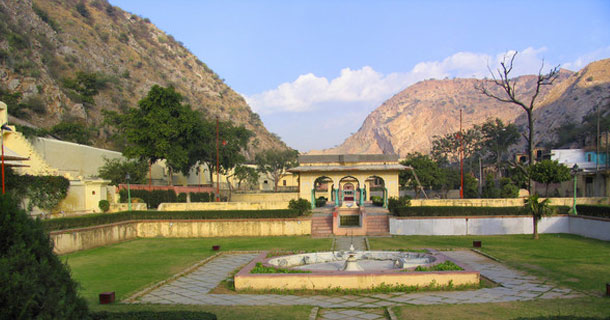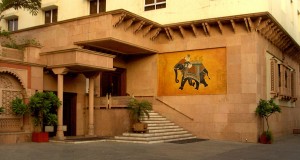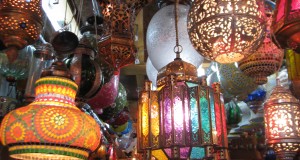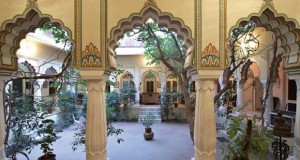Surrounded on three sides by the rugged Aravali hills, Jaipur is the picturesque capital of Rajasthan. It takes its name from the prince, soldier and astronomer J Singh II, who moved his capital here in 1727. The old capital, Amber (or Amer), had, long been a stronghold of Rajput power, but had become too cramped at its mounta site. Although it had been attacked by various rulers of Delhi the Kachhwaha rule were secure in the Jaigarh fort.  When the Mughals arrived Maharajah Mansingh (t then ruler of Amber) guaranteed the safety of his kingdom on becoming a gene) and minister in Akbar’s court and by giving his sister to the Emperor in marriage With his new position and wealth Man Singh built the imposing fort-palace of Anil below the earlier fort. But the Kachhwahas of Amber were seen by other Rajput as having sold out, a blot on her record which transferred to Jaipur, and which time has not erased.
When the Mughals arrived Maharajah Mansingh (t then ruler of Amber) guaranteed the safety of his kingdom on becoming a gene) and minister in Akbar’s court and by giving his sister to the Emperor in marriage With his new position and wealth Man Singh built the imposing fort-palace of Anil below the earlier fort. But the Kachhwahas of Amber were seen by other Rajput as having sold out, a blot on her record which transferred to Jaipur, and which time has not erased.
Jai Singh built Jaipur as a planned city. It is divided into seven rectangular bloc built on a grid of nine squares as detailed in the Shilpa Shasta, an ancient Hindu architectural treatise. The broad well-laid-out main streets (33.8 m: 110 ft wide) cut the side lanes at sharp right-angles. The entire city is encircled by fortified, crenellated walls, and guarded by seven gates.
An attraction of Jaipur is its distinctive pink-orange colouring. The whole of the old city, including many fine palaces and buildings, was constructed from solid blocks of sandstone or faced with the same stone. But it was only in 1853, when Prince Albert visited and the city was painted pink for the first time that it gained , its famous title of the ‘Pink City’. The soft glow of its buildings and monuments, most magical at sunset, have fascinated visitors for over two centuries.
Jaipur is the real gateway to Rajasthan. Though a very busy, commercial capital, the underlying Rajput spirit stubbornly lives on.  The traditional dress, decoration and colour can be seen everywhere—the station porters in bright red turbans and jackets, the veiled women in loose-flowing robes of red, orange and yellow, the tiny khol-eyed infants in swaddling clothes of rich, embroidered silk. Inside the old city, them atmosphere is electric—a bustling, jolly round of ringing bicycle bells, teeming traffic, itinerant sacred cows, busy bazaars and tourist-hungry rickshaws.
The traditional dress, decoration and colour can be seen everywhere—the station porters in bright red turbans and jackets, the veiled women in loose-flowing robes of red, orange and yellow, the tiny khol-eyed infants in swaddling clothes of rich, embroidered silk. Inside the old city, them atmosphere is electric—a bustling, jolly round of ringing bicycle bells, teeming traffic, itinerant sacred cows, busy bazaars and tourist-hungry rickshaws.
Situated on the plains, Jaipur gets pretty hot. Coolest from October to February, busiest and most popular from January to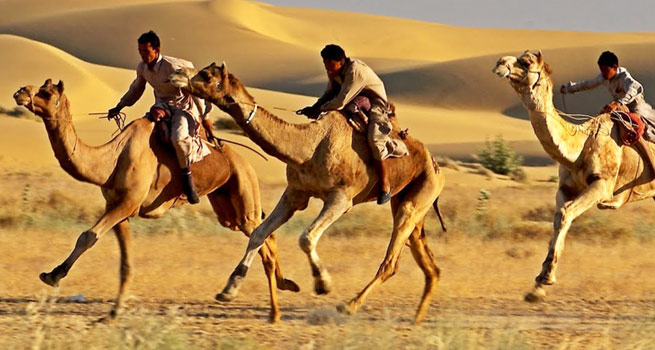 March, it remains pleasant to mid-April (nDot too hot but less crowded). Two important dates for your diary are the Elephant Festival just before Holi in March and the spring festival of Gangaur in March/April which culminates on the 17th day after Holi when the Goddess Gauri (Parvati) is ‘paraded from the City Palace and through the city streets. The Teej festival during early August is an important festival for local women and celebrates the monsoon.
March, it remains pleasant to mid-April (nDot too hot but less crowded). Two important dates for your diary are the Elephant Festival just before Holi in March and the spring festival of Gangaur in March/April which culminates on the 17th day after Holi when the Goddess Gauri (Parvati) is ‘paraded from the City Palace and through the city streets. The Teej festival during early August is an important festival for local women and celebrates the monsoon.
Across the formal garden is the Sukh Niwas, or Hall of Pleasure. The main chamber has decorative relief work in plaster and a marble cascade to the rear. Together with the breeze passing through its perforated marble screen, this water cascade served as a cooling device during the summer. The pavilion doors still retain some of the original ivory and sandalwood inlay work. On the way out, steal a minute or two to appreciate the beautiful gardens.
perforated marble screen, this water cascade served as a cooling device during the summer. The pavilion doors still retain some of the original ivory and sandalwood inlay work. On the way out, steal a minute or two to appreciate the beautiful gardens.
From Amber, the tour returns to town via Gaitor, the royal cremation ground. This site, located some 8 km (5 miles) out of Jaipur, contains a number of elegant chhatris or cenotaphs of various kings and queens. The white marble structure of Jai Singh II, with its intricately carved dome and 20 supporting pillars, is the most beautiful. Members of the royal family, mainly the ladies, are still cremated at Gaitor, a new cenotaph being erected for each fresh casualty.
Back in the walled city of Jaipur enter the precincts of the City Palace covering one-seventh of the original city’s area. Begin with a visit to Jai Singh’s most interesting legacy, the Mantar Mantar observatory. The starstruck young ruler first conceived the idea in 1718, and sent out scholars to study foreign observatories in Britain, Greece, Arabia and Portugal and gather information. An experimental prototype at Delhi (1724) was followed by others at Ujjain, Benares and Mathura. Then, in 1728, he realised his dream of India’s greatest astronomical observatory here at Jaipur. It is the largest of the series, and has the unique Rashi Valnya instrument in which Jai Singh himself used to sit to make his observations.
precincts of the City Palace covering one-seventh of the original city’s area. Begin with a visit to Jai Singh’s most interesting legacy, the Mantar Mantar observatory. The starstruck young ruler first conceived the idea in 1718, and sent out scholars to study foreign observatories in Britain, Greece, Arabia and Portugal and gather information. An experimental prototype at Delhi (1724) was followed by others at Ujjain, Benares and Mathura. Then, in 1728, he realised his dream of India’s greatest astronomical observatory here at Jaipur. It is the largest of the series, and has the unique Rashi Valnya instrument in which Jai Singh himself used to sit to make his observations.
Renovated in 1901, this strange collection of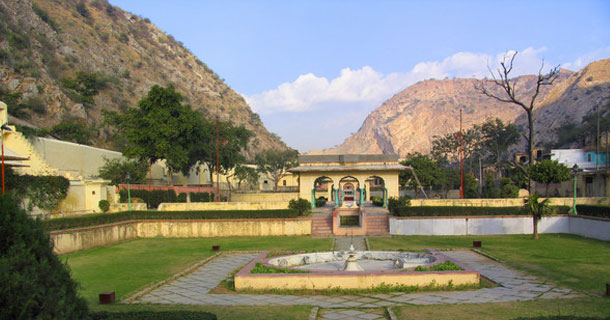 surreal, yellow-sandstone sculptures each has a specific astronomical function, be it to measure the sun’s declination, azimuth or altitude, or to determine eclipses or the declination of fixed stars and planets. The tall sundial, with its 30-m (97-ft) high gnomon, is the most notable instrument. It casts a shadow which moves some 4 m (13 ft) each hour, giving the time down to 2-second accuracy—though only, of course, when the sun is shining Hours are 9 am to 5 pm daily. Entry is Rsl , free on Mondays.
surreal, yellow-sandstone sculptures each has a specific astronomical function, be it to measure the sun’s declination, azimuth or altitude, or to determine eclipses or the declination of fixed stars and planets. The tall sundial, with its 30-m (97-ft) high gnomon, is the most notable instrument. It casts a shadow which moves some 4 m (13 ft) each hour, giving the time down to 2-second accuracy—though only, of course, when the sun is shining Hours are 9 am to 5 pm daily. Entry is Rsl , free on Mondays.
From the observatory enter the City Palace, an imposing blend of traditional Rajasthani and Mughal architecture. Some of the buildings within the Palace have become the Sawai Man Singh II Museum. The first building is the two-storey Mubarak Mahal the first floor of which now contains the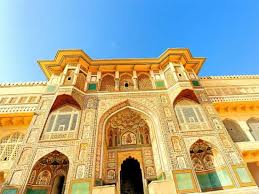 Textile and Costume Museum. To the north-west of the courtyard is the Arms and Armour Gallery with maipresnive arayd of weapons. From the first courtyard enter a second area pasing rwStoiutihgn h guagnhe hi md opPoreosclioeve, greadte iwna pya, therned .b In thre Haal osf Prisvate Audience, Diwan-i-Khas (complete with antique carpets mid chandeliers which are unrolled and unbagged for holy festivals) facing the gateway, are two huge silver urns built for Sawai Madhu Singh in 1902 to carry water tcfVheo rRrivoeIorn GaaInmtgai’ oonsn hi.s visito London for Edward Trough a small portrait gallery to the north of the Diwan-i-Khas, watched over by a Chinese Buddha, you come out into the spacious courtyard. Here dancing used In take place, watched by the Maharanis in the balconies above. The seven-storey Chandra Mahal is today the home of present Maharajah and his family.
Textile and Costume Museum. To the north-west of the courtyard is the Arms and Armour Gallery with maipresnive arayd of weapons. From the first courtyard enter a second area pasing rwStoiutihgn h guagnhe hi md opPoreosclioeve, greadte iwna pya, therned .b In thre Haal osf Prisvate Audience, Diwan-i-Khas (complete with antique carpets mid chandeliers which are unrolled and unbagged for holy festivals) facing the gateway, are two huge silver urns built for Sawai Madhu Singh in 1902 to carry water tcfVheo rRrivoeIorn GaaInmtgai’ oonsn hi.s visito London for Edward Trough a small portrait gallery to the north of the Diwan-i-Khas, watched over by a Chinese Buddha, you come out into the spacious courtyard. Here dancing used In take place, watched by the Maharanis in the balconies above. The seven-storey Chandra Mahal is today the home of present Maharajah and his family.
The and floor is open to the public and leads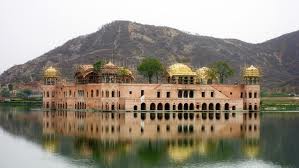 onto a lawn with the 356 fountains still orking order, which perfectly complement the beautiful gardens. So do the green, let and red chandeliers and the plain marble doors leading off the mosaic courtrd. The Art Gallery and main Museum are housed in the Hall of Public Audience to the south-east of the inner courtyard. The gallery has some of India’s largest and Idrichest carpets, most of them from Herat (Afghanistan) and Lahore (Pakistan). Noveral date back to AD 1625 and the largest is 18 m (58 ft) long. Also in this section are a collection of ivory elephant howdahs, and the second largest chandelier (Czech) In the country. The art gallery is famous for its Jaipur and Mughal miniature paintings, and for its 20 000 handwritten Sanskrit manuscripts (only a few on show—you’ll have to ask if you want to see more).
onto a lawn with the 356 fountains still orking order, which perfectly complement the beautiful gardens. So do the green, let and red chandeliers and the plain marble doors leading off the mosaic courtrd. The Art Gallery and main Museum are housed in the Hall of Public Audience to the south-east of the inner courtyard. The gallery has some of India’s largest and Idrichest carpets, most of them from Herat (Afghanistan) and Lahore (Pakistan). Noveral date back to AD 1625 and the largest is 18 m (58 ft) long. Also in this section are a collection of ivory elephant howdahs, and the second largest chandelier (Czech) In the country. The art gallery is famous for its Jaipur and Mughal miniature paintings, and for its 20 000 handwritten Sanskrit manuscripts (only a few on show—you’ll have to ask if you want to see more).
the palace and museum are open 9.30 am  to 4.45 pm daily (art gallery closed Sundays ). Entrance is Rs6 (half-price for students and teachers). For most people, this will be quite sufficient for one day. The afternoons are often asnd thoti, acnd akre beyst spent relaxing or athe pol. Dusk is the time to venture foforrth again, either for rowing round Moata Lake and enjoying the sunset at Amber t, or for climbing the huge sundial at Jantar Mantar to see an equally fine sunset or the pink city.
to 4.45 pm daily (art gallery closed Sundays ). Entrance is Rs6 (half-price for students and teachers). For most people, this will be quite sufficient for one day. The afternoons are often asnd thoti, acnd akre beyst spent relaxing or athe pol. Dusk is the time to venture foforrth again, either for rowing round Moata Lake and enjoying the sunset at Amber t, or for climbing the huge sundial at Jantar Mantar to see an equally fine sunset or the pink city.
Iii town, one final sight not to be missed is the Central Museum (Albert Hall). Ii forms part of the sprawling Ram Niwas Garden in the new city (10 minutes’ Walk down Chaurasta, off Tripolia Bazaar), which is also the site of a modest Zoo. maTuseum’ns Dhurbar Hdalel was built in 187, a pleasant blend of Oriental IL Victorian architecture, and houses a vast collection of portraits, miniatures, rks of art (top floor) and costumes, woodwork, brassware, jewellery and fiery (bottom floor).
Central Museum (Albert Hall). Ii forms part of the sprawling Ram Niwas Garden in the new city (10 minutes’ Walk down Chaurasta, off Tripolia Bazaar), which is also the site of a modest Zoo. maTuseum’ns Dhurbar Hdalel was built in 187, a pleasant blend of Oriental IL Victorian architecture, and houses a vast collection of portraits, miniatures, rks of art (top floor) and costumes, woodwork, brassware, jewellery and fiery (bottom floor).
RECREATION
Jaipur has Athe IbePst sUportsR facilities Rajasthan can ofer. It is most famous for polo heolresep, cahmael,n evten bicycle polo!)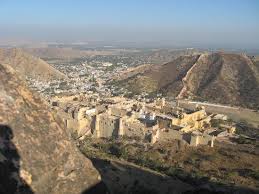 and most big hotels can arange a game. ring icMhars the polo season: five major tournaments are held here between January and For horse-riding the Rambagh Palace Hotel can arrange horses of mixed calibre. Go swimming at the Rambagh’s heavenly indoor swimming-pool—it’s well worth the Rs60 non-resident fee, especially during the mid-afternoon ‘quiet time’. Two other hotels with good pools are the Khasa Kothi, near the rail station and the Mansingh.
and most big hotels can arange a game. ring icMhars the polo season: five major tournaments are held here between January and For horse-riding the Rambagh Palace Hotel can arrange horses of mixed calibre. Go swimming at the Rambagh’s heavenly indoor swimming-pool—it’s well worth the Rs60 non-resident fee, especially during the mid-afternoon ‘quiet time’. Two other hotels with good pools are the Khasa Kothi, near the rail station and the Mansingh.
Fishing is possible at Ramgarh Lake 30 km (19 miles) away but poor monsoons in recent years have led to a reduction in the level of the lake; permits from Gangaur Tourist Bungalow (tel 74373). Most major hotels can arrange tennis, squash and good sports activities. For cultural shows and entertainments, buy a Rajasthan Echo (for current programmes) or visit Ravendra Manch, near Albert Hall. Jaipur has one of India’s best cinemas—the Raj Mandir. A few others,

